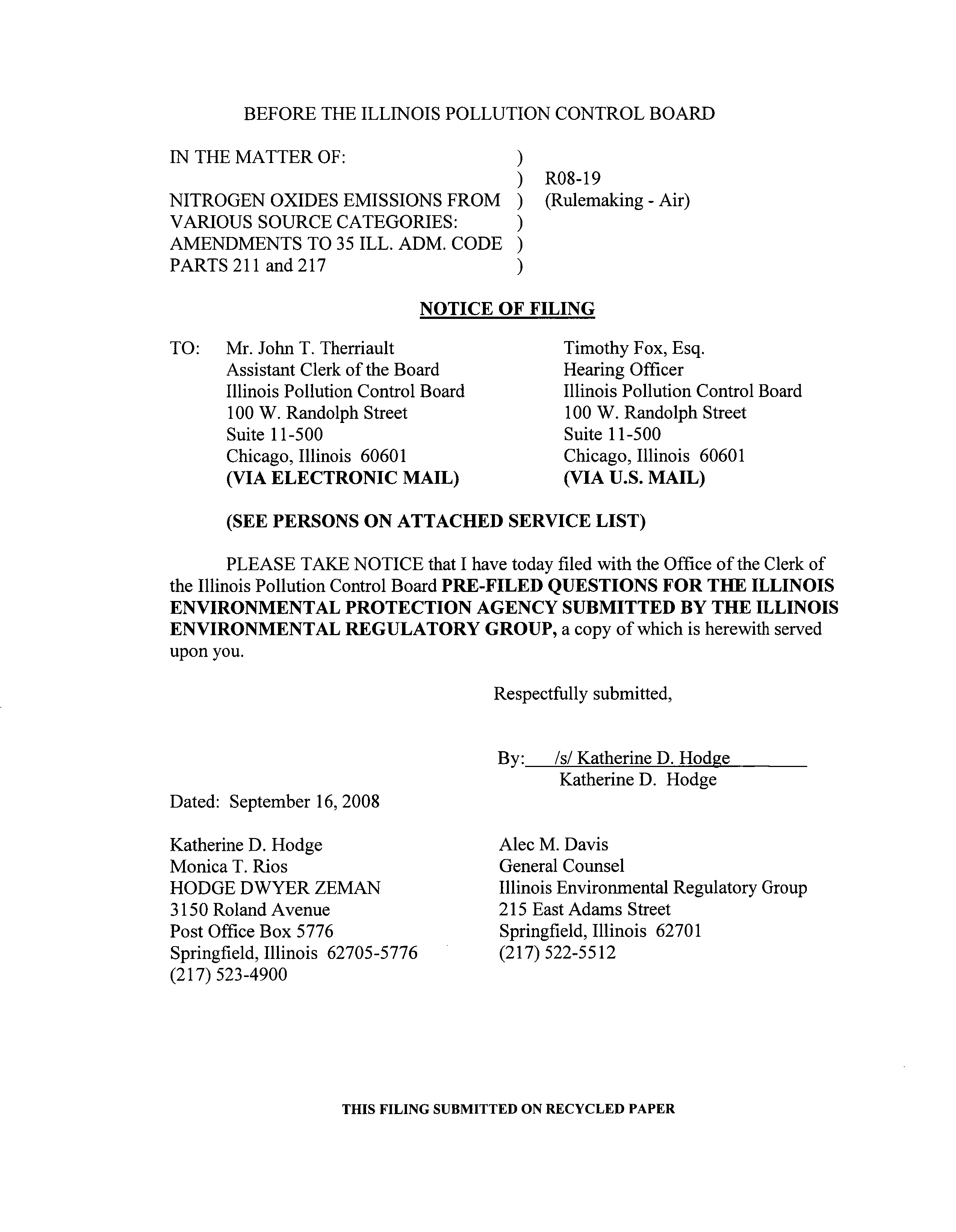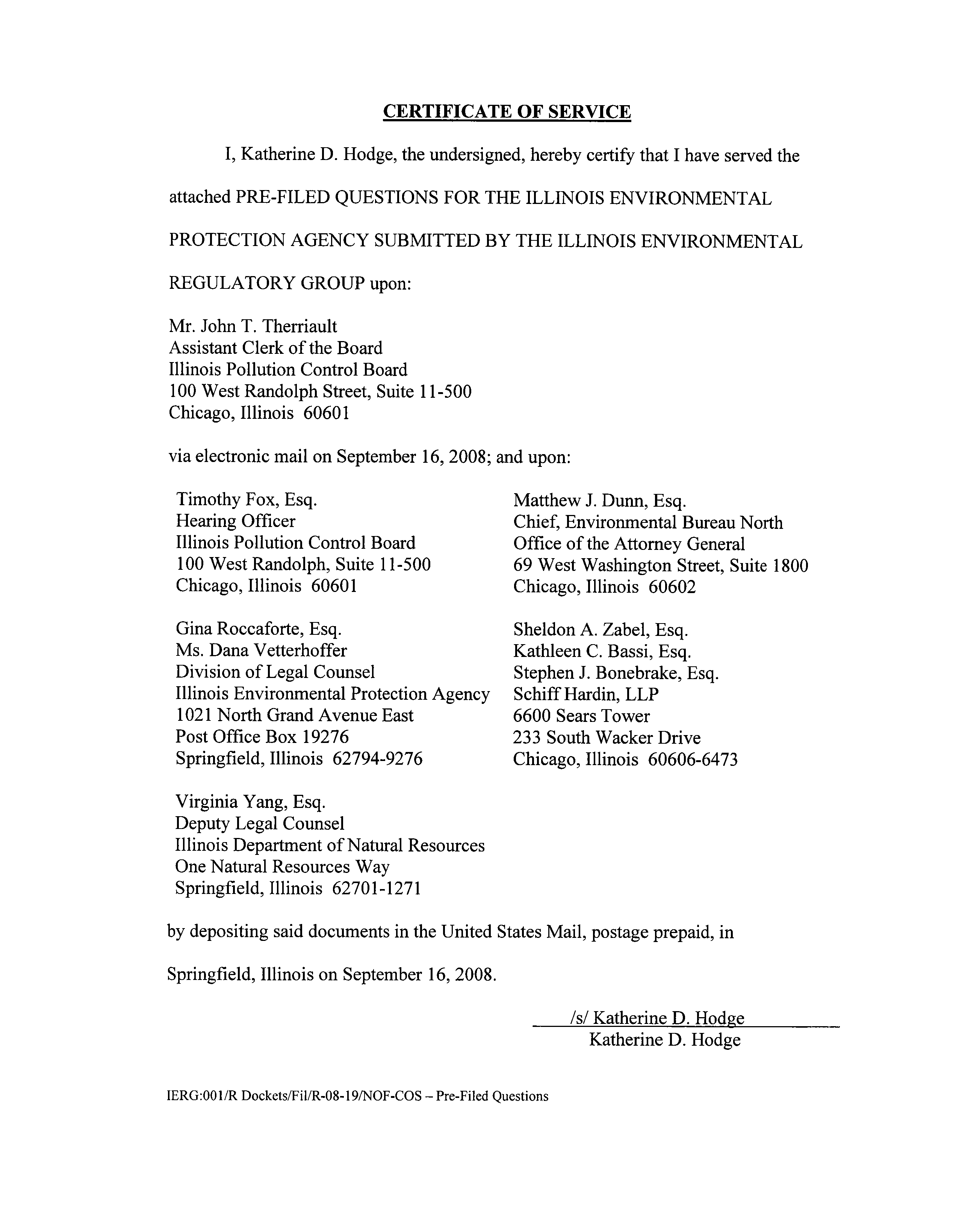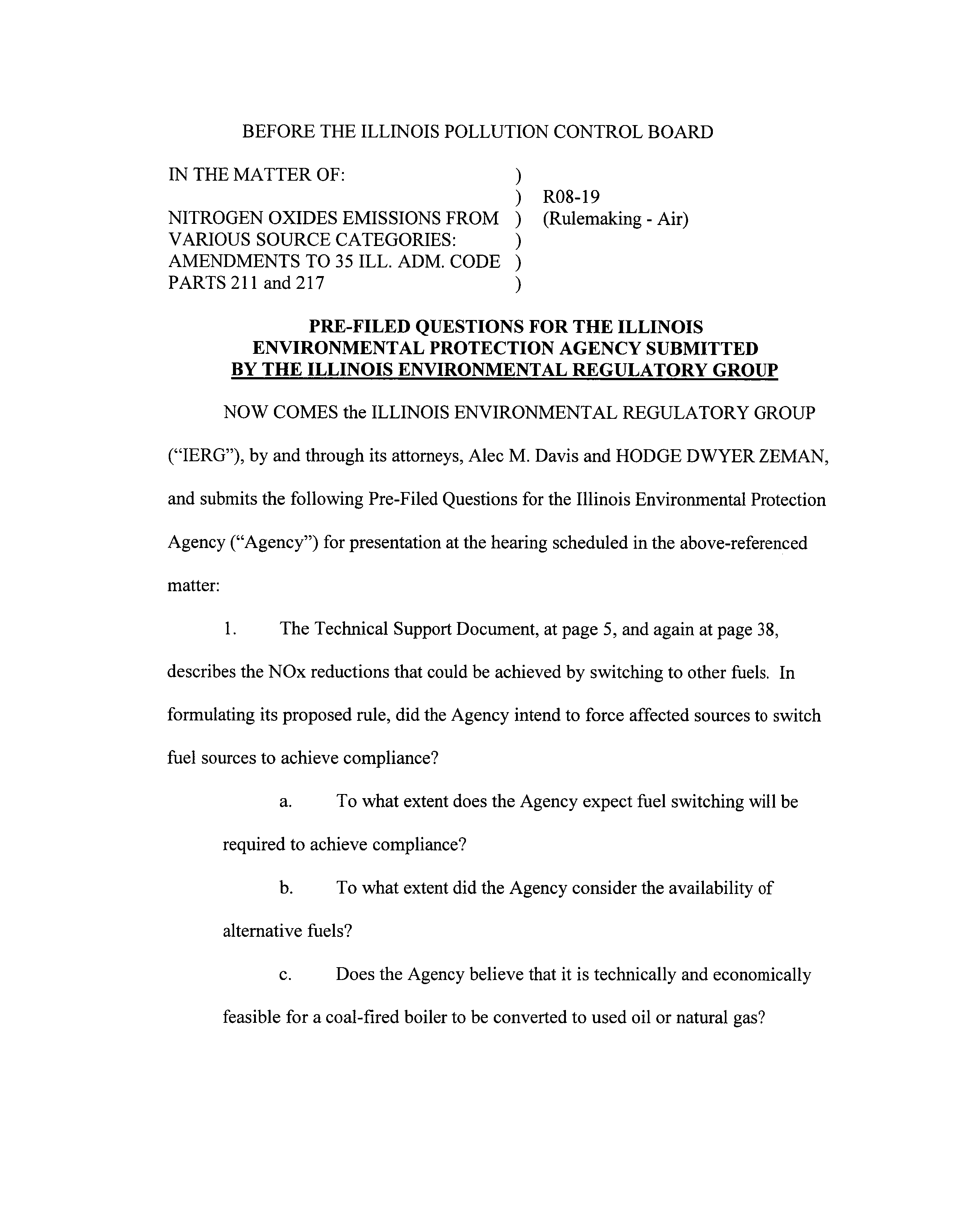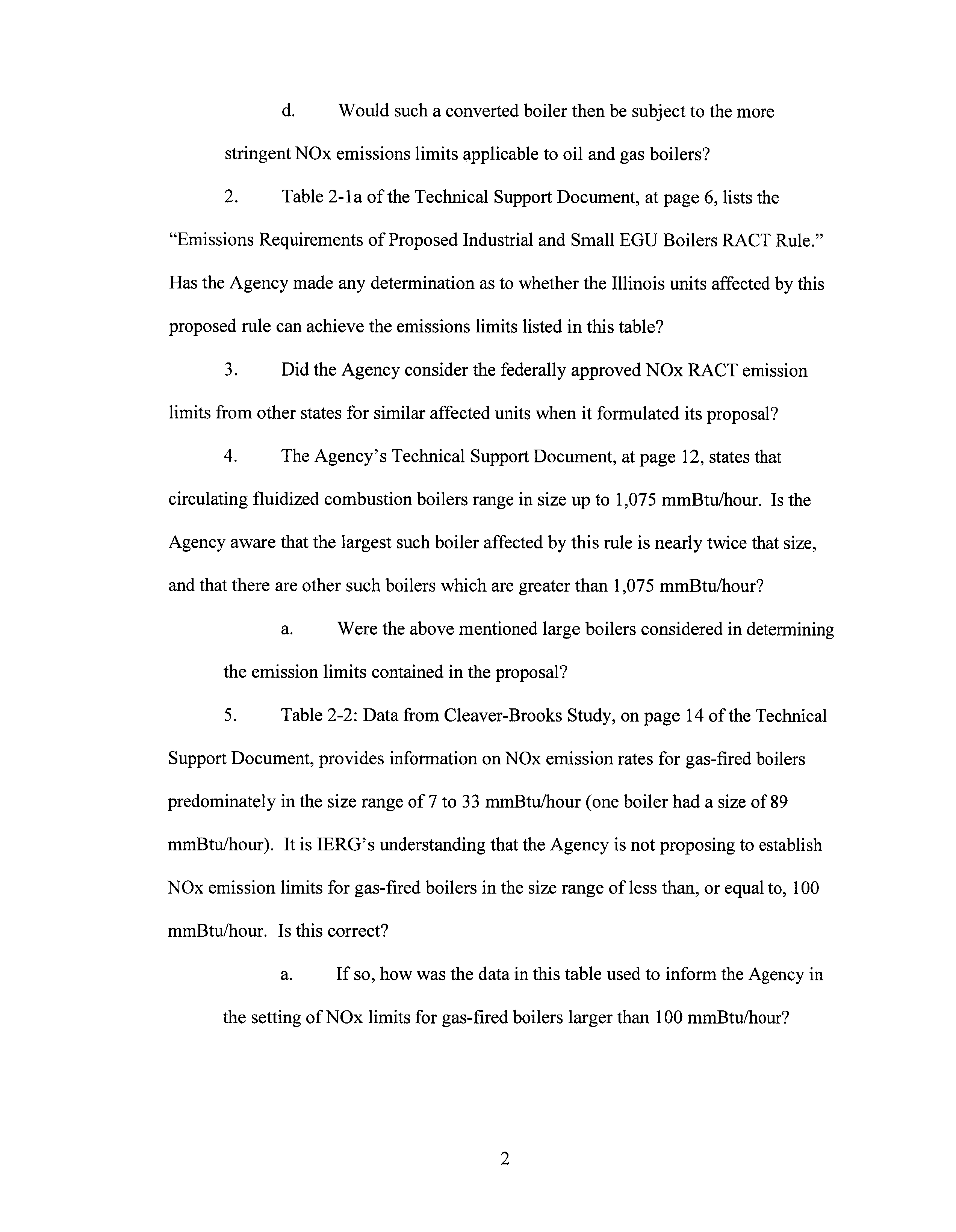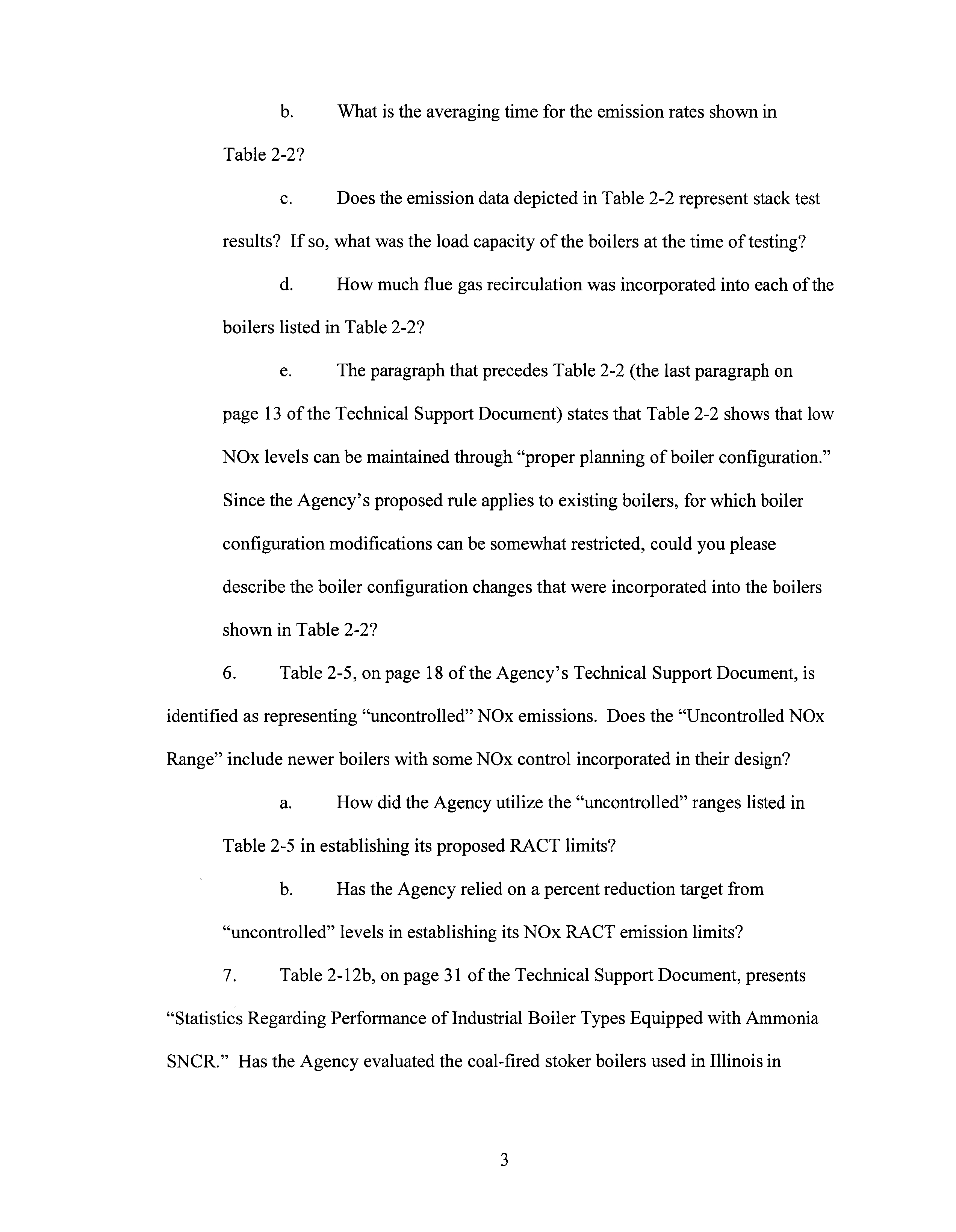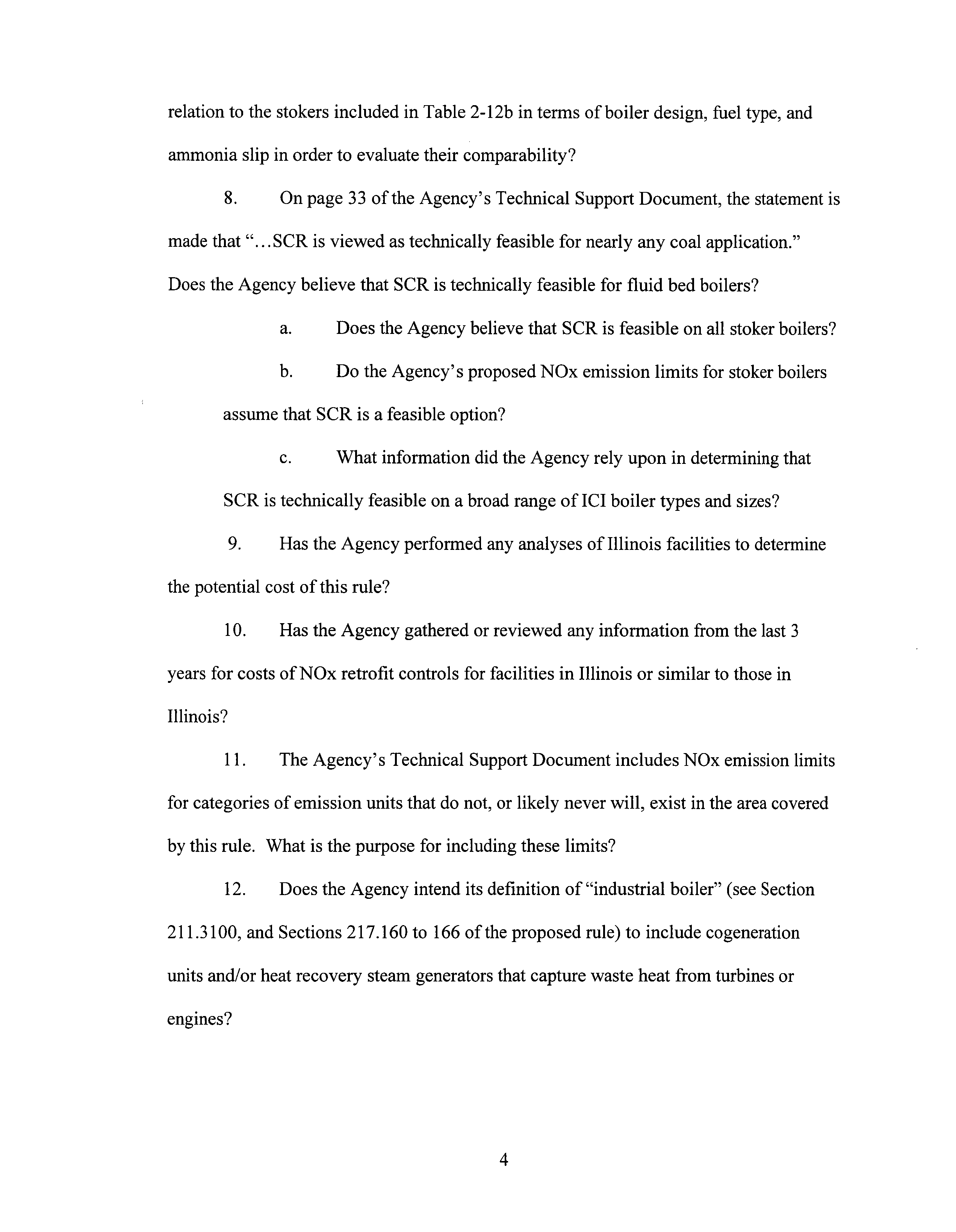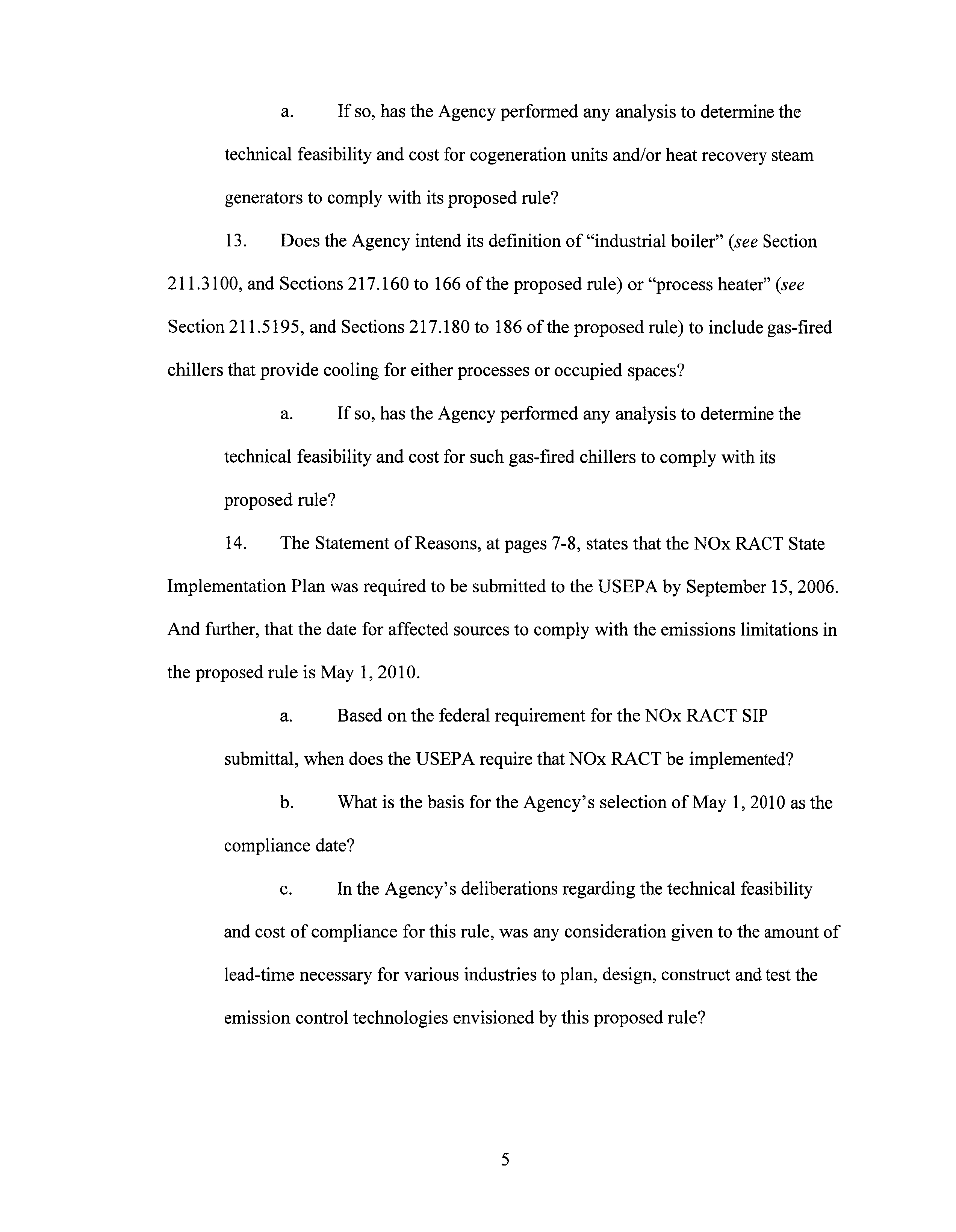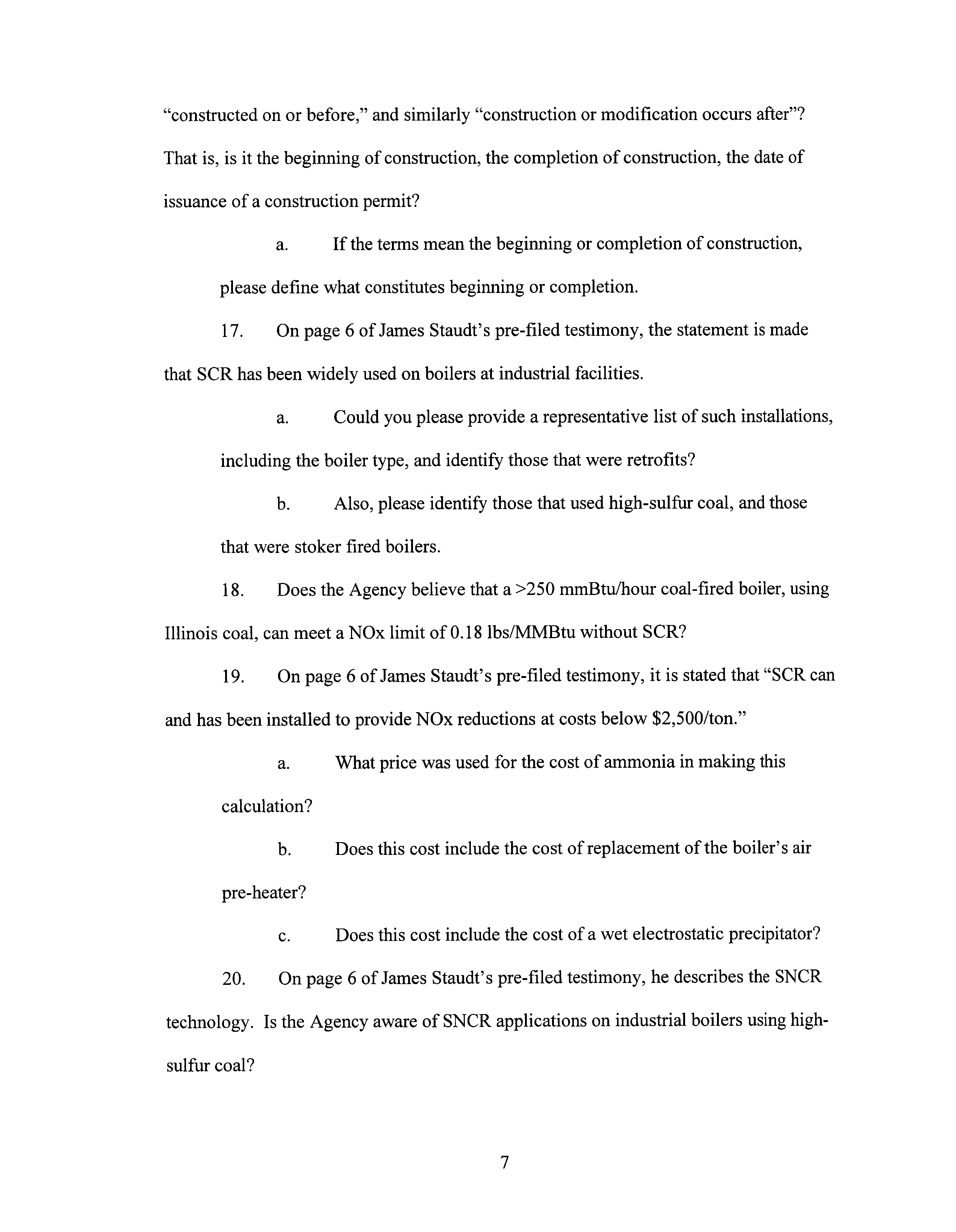BEFORE THE ILLINOIS POLLUTION CONTROL BOARD
IN
THE MATTER OF:
)
NITROGEN OXIDES EMISSIONS FROM )
VARIOUS SOURCE CATEGORIES: )
AMENDMENTS TO 35 ILL. ADM. CODE )
PARTS 211 and 217
)
R 08-19
(Rulemaking - Air)
N OTICE OF
FILING
TO: Mr. John T. Therriault
Assistant Clerk of
the Board
Illinois Pollution Control Board
100 W. Randolph Street
Suite 11-500
Chicago,
Illinois 60601
(VIA ELECTRONIC
MAIL)
Timothy Fox,
Esq.
Hearing Officer
Illinois Pollution Control Board
100 W. Randolph Street
Suite 11-500
Chicago, Illinois 60601
(VIA
U.S. MAIL)
(SEE PERSONS ON ATTACHED SERVICE LIST)
PLEASE TAKE NOTICE that I have today filed with the Office of the Clerk of
the Illinois Pollution Control Board PRE-FILED
QUESTIONS FOR THE ILLINOIS
ENVIRONMENTAL
PROTECTION AGENCY SUBMITTED BY THE ILLINOIS
ENVIRONMENTAL REGULATORY GROUP, a copy of which is herewith served
upon you.
Respectfully submitted,
By: /s/
Katherine D. Hodge
Katherine D. Hodge
Dated:
September
16, 2008
Katherine D. Hodge
Monica T. Rios
HODGE DWYER
ZEMAN
3150
Roland Avenue
Post Office Box 5776
Springfield, Illinois 62705-5776
(217) 523-4900
Alec M. Davis
General Counsel
Illinois Environmental Regulatory Group
215 East Adams Street
Springfield, Illinois 62701
(217) 522-5512
THIS FILING SUBMITTED ON RECYCLED PAPER
Electronic Filing - Received, Clerk's Office, September 16, 2008
CERTIFICATE
OF SERVICE
I, Katherine
D. Hodge, the undersigned, hereby certify that I have served
the
attached PRE-FILED QUESTIONS FOR
THE ILLINOIS ENVIRONMENTAL
PROTECTION AGENCY
SUBMITTED BY THE ILLINOIS ENVIRONMENTAL
REGULATORY GROUP upon:
Mr. John T.
Therriault
Assistant Clerk
of the Board
Illinois Pollution Control Board
100 West Randolph Street, Suite 11-500
Chicago, Illinois 60601
via electronic
mail on September 16, 2008; and upon:
Timothy Fox, Esq.
Hearing Officer
Illinois Pollution Control Board
100 West
Randolph, Suite 11-500
Chicago, Illinois
60601
Matthew J. Dunn, Esq.
Chief, Environmental Bureau North
Office of the
Attorney General
69 West Washington
Street, Suite 1800
Chicago, Illinois 60602
Gina Roccaforte, Esq.
Ms. Dana Vetterhoffer
Division of Legal
Counsel
Illinois Environmental Protection
Agency
1021 North Grand Avenue East
Post Office Box 19276
Springfield, Illinois 62794-9276
Virginia
Yang, Esq.
Deputy Legal Counsel
Illinois Department of Natural Resources
One Natural Resources Way
Springfield,
Illinois 62701-1271
Sheldon A. Zabel,
Esq.
Kathleen C. Bassi, Esq.
Stephen J. Bonebrake, Esq.
Schiff Hardin, LLP
6600 Sears Tower
233 South Wacker Drive
Chicago, Illinois 60606-6473
by depositing said documents in the United
States Mail, postage prepaid, in
Springfield, Illinois on September 16, 2008.
/s/ Katherine D. Hodge
Katherine D. Hodge
I ERG:001/R Dockets/Fil/R-08-19/NOF-COS
-Pre-Filed Questions
Electronic Filing - Received, Clerk's Office, September 16, 2008
BEFORE THE ILLINOIS POLLUTION
CONTROL BOARD
IN THE MATTER OF:
)
R08-19
NITROGEN
OXIDES EMISSIONS FROM ) (Rulemaking - Air)
VARIOUS SOURCE CATEGORIES: )
AMENDMENTS TO 35 ILL. ADM. CODE )
PARTS 211 and 217
)
PRE-FILED QUESTIONS FOR THE ILLINOIS
ENVIRONMENTAL
PROTECTION AGENCY SUBMITTED
BY THE ILLINOIS ENVIRONMENTAL
REGULATORY GROUP
NOW
COMES the ILLINOIS ENVIRONMENTAL REGULATORY GROUP
("IERG"), by and through its attorneys, Alec M. Davis and HODGE
DWYER ZEMAN,
and submits the following Pre-Filed Questions for the Illinois Environmental Protection
Agency ("Agency") for
presentation at the hearing scheduled in the above-referenced
matter:
l.
The Technical Support Document, at page 5, and again at page 38,
describes the NOx reductions that could be achieved
by switching to other fuels. In
formulating its proposed rule, did the Agency intend to force affected sources to switch
fuel sources to achieve compliance?
a.
To what extent does the Agency expect fuel switching will
be
required to achieve compliance?
b.
To what extent did the Agency consider the availability
of
alternative fuels?
c.
Does the
Agency believe that it is technically and economically
feasible for a coal-fired boiler to be converted to used oil or natural gas?
Electronic Filing - Received, Clerk's Office, September 16, 2008
d.
Would such a converted boiler then be subject to the more
stringent NOx emissions limits
applicable to oil and gas boilers?
2.
Table 2-la of the Technical Support Document, at page 6, lists the
"Emissions Requirements of Proposed Industrial and
Small EGU Boilers RACT Rule."
Has the Agency made any determination as to whether the Illinois units affected
by this
proposed rule
can achieve the emissions limits listed in this table?
3.
Did the Agency
consider the federally approved NOx RACT emission
limits from other states for similar affected units when it formulated its
proposal?
4.
The Agency's Technical
Support Document, at page 12, states that
circulating fluidized combustion boilers range in size up to 1,075
mmBtu/hour. Is the
Agency aware that the largest
such boiler affected by this rule is nearly twice that size,
and that there are other such boilers which are greater than 1,075
mmBtu/hour?
a.
Were the above mentioned large boilers considered in determining
the emission limits contained in the
proposal?
5.
Table 2-2: Data from Cleaver-Brooks Study, on page 14
of the Technical
Support
Document,
provides information on NOx emission rates for gas-fired boilers
predominately in the size range of 7 to 33 mmBtu/hour (one
boiler had a size of 89
mmBtu/hour). It is IERG's understanding that the Agency is not proposing to establish
NOx emission limits for gas-fired boilers in the size range of less than, or equal
to, 100
mmBtu/hour. Is this correct?
a.
If
so,
how
was the data
in this table used to inform
the Agency in
the setting of NOx limits for gas-fired boilers larger than 100 mmBtu/hour?
Electronic Filing - Received, Clerk's Office, September 16, 2008
b.
What is the averaging time for the emission rates
shown in
Table 2-2?
c.
Does the emission data depicted in Table 2-2 represent stack test
results? If so, what was the load capacity of the boilers at the time
of
testing?
d.
How much flue gas recirculation was incorporated into each of the
boilers listed in Table 2-2?
e.
The paragraph that precedes Table 2-2 (the last paragraph on
page 13
of
the Technical
Support
Document)
states that Table 2-2 shows that low
NOx levels can be maintained through "proper planning of boiler configuration."
Since the Agency's proposed rule applies to existing boilers, for which boiler
configuration modifications
can be somewhat restricted, could you please
describe the boiler configuration changes that were incorporated into the boilers
shown in Table 2-2?
6.
Table 2-5, on page 18 of the Agency's Technical Support Document, is
identified as representing "uncontrolled" NOx emissions. Does the "Uncontrolled NOx
Range" include newer boilers with some NOx control incorporated in their design?
a.
How did the Agency utilize the "uncontrolled" ranges listed in
Table 2-5 in establishing its proposed RACT limits?
b.
Has the Agency relied on a percent reduction target from
"uncontrolled" levels in establishing its NOx RACT emission limits?
7.
Table 2-12b, on page 31 of the Technical Support Document, presents
"Statistics Regarding Performance of Industrial Boiler Types Equipped with Ammonia
SNCR." Has the Agency evaluated the coal-fired stoker boilers used in Illinois in
Electronic Filing - Received, Clerk's Office, September 16, 2008
relation to
the stokers included in Table 2-12b in terms of boiler design, fuel type, and
ammonia slip in order to evaluate their comparability?
8.
On page 33 of the Agency's Technical Support Document, the statement is
made that "... SCR is viewed as technically feasible for
nearly any coal application."
Does the Agency believe that SCR is technically feasible for fluid
bed boilers?
a.
Does the Agency believe that SCR is feasible on all stoker boilers?
b.
Do the Agency's proposed NOx emission
limits for stoker boilers
assume that SCR is a feasible option?
c.
What information did the Agency
rely upon in determining that
SCR is technically feasible on a broad range of ICI boiler types and
sizes?
9.
Has
the
Agency
performed any analyses of Illinois facilities to determine
the potential cost of this rule?
10. Has the Agency gathered or reviewed any information from the last 3
years for costs of NOx retrofit controls for facilities in
Illinois or similar to those in
Illinois?
11.
The Agency's Technical Support Document includes NOx emission limits
for categories of emission units that do not, or likely never will, exist in the area covered
by this rule. What is the purpose for including these limits?
12. Does the Agency intend its definition of "industrial boiler" (see Section
211.3 100, and Sections 217.160 to 166 of the proposed rule) to include cogeneration
units
and/or
heat recovery
steam
generators that capture waste heat from
turbines or
engines?
Electronic Filing - Received, Clerk's Office, September 16, 2008
a.
If so, has the Agency performed any analysis
to determine the
technical feasibility and cost for cogeneration units and/or heat recovery steam
generators to comply
with
its
proposed rule?
13. Does the Agency intend its definition of "industrial boiler" (see Section
211.3 100,
and Sections 217.160
to 166 of the proposed rule) or "process heater" (see
Section 211.5195, and Sections 217.180 to 186 of the proposed rule) to include gas-fired
chillers that provide cooling for either processes or occupied spaces?
a.
If so, has the Agency performed any
analysis to determine the
technical feasibility and cost for such gas-fired chillers to comply with its
proposed rule?
14. The Statement of Reasons, at pages 7-8, states that the NOx
RACT State
Implementation Plan was required to be submitted to the USEPA by September 15, 2006.
And further, that the date for affected sources to comply with the emissions limitations
in
the
proposed rule is May 1, 2010.
a.
Based on the federal requirement for the NOx RACT
SIP
submittal, when does the USEPA require that NOx RACT be implemented?
b.
What is the basis for the Agency's selection of May 1, 2010 as the
compliance date?
c.
In the Agency's deliberations regarding the technical feasibility
and cost
of
compliance for this rule, was any consideration given to the
amount of
lead-time necessary for various industries to plan, design, construct and test the
emission control technologies envisioned
by this proposed rule?
Electronic Filing - Received, Clerk's Office, September 16, 2008
d.
Does the Agency believe that
the amount of time from rule
promulgation to the compliance date has a significant bearing on the ultimate cost
and feasibility
of compliance?
e.
Is the concept of "Reasonably Available"
a factor of the
compliance date such that the technical options and economic
cost for Reasonably
Available Control Technology
would be dependent on the amount of time
between rule promulgation and compliance?
15.
Section
217.158
of the proposed rule describes the Emissions Averaging
Plans. It is IERG's understanding that the Agency is not allowing
emission units into an
averaging plan if they commenced operation after January 1, 2002, unless they are
deemed to be a "replacement unit."
Is this correct?
a.
What is the basis for the Agency's determination to
exclude such
units?
b.
Has the Agency attempted to assess
the impact that such a
restriction might have on environmental decision-making at affected facilities?
c.
Has the Agency considered how it will
make a determination of
whether a new unit constitutes a "replacement unit," especially as emphasis is
growing to improve
energy efficiency and reduce greenhouse gasses, thereby
making it unlikely that a "replacement unit" would be exactly the "same"
as the
unit(s) it replaces?
16. Section 217.154
of the proposed regulation sets forth the performance
testing requirements. Both subsections (a) and (b) refer to the date of emission unit
construction
or
modification.
Could
the
Agency please clarify what constitutes
Electronic Filing - Received, Clerk's Office, September 16, 2008
"constructed on or before," and similarly
"construction or modification occurs after"?
That is, is it the beginning of construction, the completion of construction, the date
of
issuance of a construction permit?
a.
If the terms mean the beginning or completion of construction,
please define what constitutes
beginning or completion.
17. On
page 6 of James Staudt's pre-filed testimony, the statement is made
that SCR has been widely used on boilers at industrial facilities.
a.
Could you please provide a
representative list of such installations,
including
the boiler type, and identify those that were retrofits?
b.
Also, please identify those
that used high-sulfur coal, and those
that were stoker
fired boilers.
18. Does the Agency believe that a >250
mmBtu/hour coal-fired boiler, using
Illinois coal, can meet a NOx
limit
of
0.18 lbs/MMBtu without SCR?
19. On page 6 of James Staudt's pre-filed testimony,
it is stated that "SCR can
and has been installed to provide NOx reductions
at costs below $2,500/ton."
a.
What price
was used for the cost of ammonia in making this
calculation?
b.
Does this cost
include the cost of replacement of the boiler's air
pre-heater?
c.
Does this
cost include the cost of a wet electrostatic precipitator?
20. On
page 6 of James Staudt's pre-filed testimony,
he describes the SNCR
technology. Is the Agency aware of SNCR
applications on industrial boilers using high-
sulfur coal?
Electronic Filing - Received, Clerk's Office, September 16, 2008
a.
Could you please describe how the formation of ammonium bi-
sulfate is managed, to avoid corrosion problems?
b . What provisions
need to be made to accommodate boilers with
frequent load swings?
c.
21.
How does SNCR affect the turn down ratio of the boiler?
Does
the
use
of SCR
or SNCR affect the ability to beneficially re-use ash?
IERG reserves the right to supplement these Pre-Filed Questions.
Respectfully submitted,
ILLINOIS ENVIRONMENTAL
REGULATORY GROUP
By: /s/ Alec M. Davis
Alec M. Davis
Dated: September 15, 2008
Katherine D. Hodge
Monica T. Rios
HODGE DWYER ZEMAN
3150
Roland Avenue
Post Office Box 5776
Springfield, Illinois 62705-5776
(217) 523-4900
Alec M. Davis
General
Counsel
Illinois Environmental Regulatory Group
215 East Adams Street
Springfield, Illinois 62701
(217) 522-5512
I
ERG:001/RDoc/Fil/R0819/lERG
Pre-filed Questions
Electronic Filing - Received, Clerk's Office, September 16, 2008
